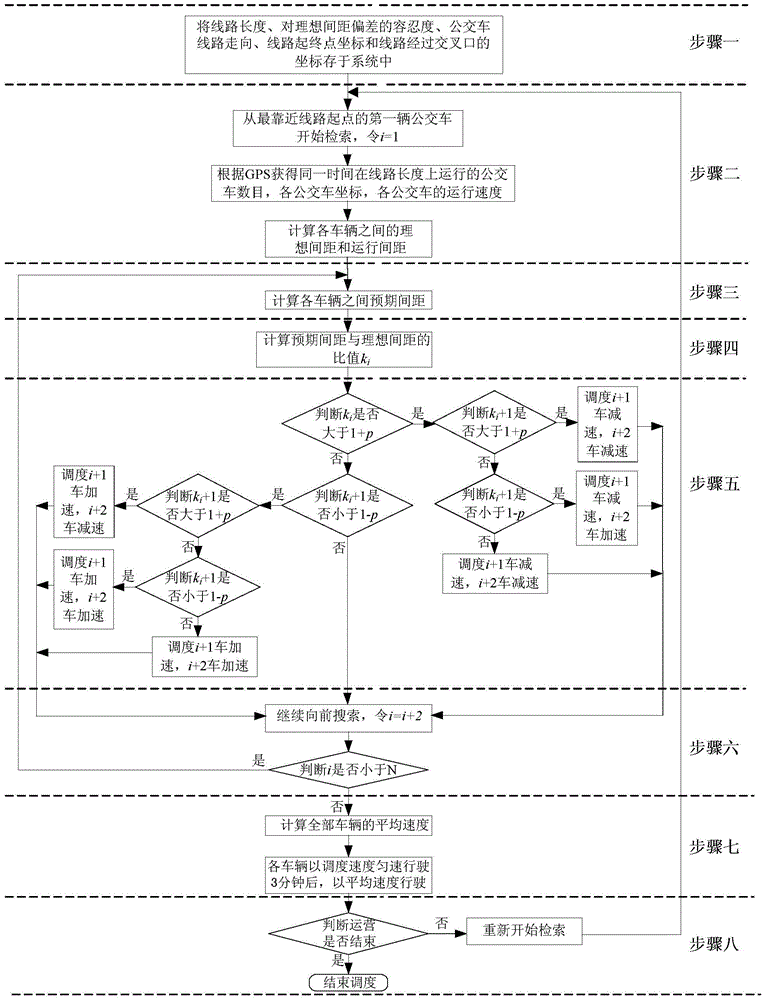A scheduling method based on gps technology to prevent buses from concentrating at stations
A dispatching method, bus technology, applied in the traffic control system of road vehicles, traffic control systems, instruments, etc., can solve the problems of unbalanced arrival time of multiple buses, poor punctuality of bus arrival, etc., and achieve significant Scheduling effect, solving centralized arrival station, and reducing the effect of human factor interference
- Summary
- Abstract
- Description
- Claims
- Application Information
AI Technical Summary
Problems solved by technology
Method used
Image
Examples
specific Embodiment approach 1
[0034] Specific implementation mode one: refer to Figure 1 to Figure 8 Specifically illustrate this embodiment, a kind of scheduling method based on GPS technology described in this embodiment to prevent buses from concentrating on stations, and described scheduling method includes:
[0035] Step 1. Store the length L of the bus line, the tolerance ρ to the ideal spacing deviation, the direction of the bus line, the coordinates of the starting and ending points of the bus line, and the coordinates of the line passing through the intersection in the system.
[0036] Step 2, start searching from the first bus closest to the starting point of the line, make i=1, obtain the number N of buses running on the same time line according to GPS, each bus coordinate (x i ,y i ), i∈(1,N), the running speed v of each bus i , combine the data in step 1 to calculate the running distance J between car i and car i+1 i,i+1 , and calculate the ideal spacing S of the lines L ,
[0037] Step ...
specific Embodiment approach 2
[0057] Specific embodiment two: This embodiment is to further explain the dispatching method based on GPS technology described in specific embodiment one to prevent buses from concentrating on stations. The first bus starts to retrieve, let i=1, obtain the number N of buses running on the same time line according to GPS, and the coordinates of each bus (x i ,y i ), i∈(1,N), the running speed v of each bus i , combine the data in step 1 to calculate the running distance J between car i and car i+1 i,i+1 , and calculate the ideal spacing S of the lines L The process is:
[0058] The GPS coordinates of each intersection on the bus operation line, the total number of intersections is N j , the data whose coordinates are (a,b) and the ratio of the distance in GPS to the actual distance on the road is 1:γ, γ is a natural number, which is stored in the system as basic data, and the real-time coordinates (x,y) of each bus are obtained by GPS ), the number of intersections m betwe...
specific Embodiment approach 3
[0065] Specific embodiment three: this embodiment is to further illustrate a kind of GPS technology-based dispatching method that prevents buses from concentrating on stations as described in specific embodiment one or two. In this embodiment, in step 3, use i car and Running distance J between i+1 vehicles i,i+1 , the running distance J between i+1 car and i+2 car i+1,i+2 and the speed v of car i i , i+1 car speed v i+1 and the speed v of the i+2 car i+2 Calculate the expected distance S between car i and car i+1 i,i+1 and the expected distance S between car i+1 and car i+2 i+1,i+2 The method is:
[0066] When i = 1, that is, when the retrieval is performed for the first time, the expected spacing is:
[0067] S 1,2 =J 1,2 +(v 2 -v 1 )×180,
[0068] S 2,3 =J 2,3 +(v 3 -v 2 )×180,
[0069] Among them, the unit of 180 is seconds, and 180 seconds represents a scheduling period of 3 minutes.
[0070] When i≠1, that is, when the cycle has started, the expected dis...
PUM
 Login to View More
Login to View More Abstract
Description
Claims
Application Information
 Login to View More
Login to View More - R&D
- Intellectual Property
- Life Sciences
- Materials
- Tech Scout
- Unparalleled Data Quality
- Higher Quality Content
- 60% Fewer Hallucinations
Browse by: Latest US Patents, China's latest patents, Technical Efficacy Thesaurus, Application Domain, Technology Topic, Popular Technical Reports.
© 2025 PatSnap. All rights reserved.Legal|Privacy policy|Modern Slavery Act Transparency Statement|Sitemap|About US| Contact US: help@patsnap.com



